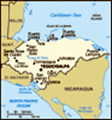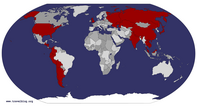Advertisement

 The Chicken buses in Central America
The Chicken buses in Central America
Take one American school bus, add bright colours and a sound system.....you got yourself a chicken bus!Chicken busing it towards the Caribbean
The gaudily decorated bus chugs along the smooth asphalt road, the azure blue Caribbean Sea to our left, while the tree covered hills rise to our right. The speakers that line the carriage strain from the levels of bass of the Latino tunes that pump out at high volume, while in front on the windscreen a large signs tells us that "God is my guide". With each gear change a black cloud of diesel smoke puffs out from the side of the bus and at each stop, many people get on, selling fried plantains, sweet breads, fruits, or giving a speech on the benefits of purchasing some new miracle cream or pamphlet on alternative medicines to make you slim. This is our first
chicken bus experience in Central America.
The chicken buses are all converted American school buses, sent to this part of the world once they are no longer deemed reliable to transport the children of the United States safely to and from school. Seats designed for 3 children are filled with 3 fully grown adults here, knees protruding towards their chins due to the short space between one seat and

 Sunrise at the dive school
Sunrise at the dive school
Utila, Bay Islands, Hondurasthe next. In an inspired move, buses that arrive here from the States in a boring yellow colour are given the Latino treatment, painted in garish colours, usually named "Esmerelda" or "Javier" or some other catchy name, a large sound system is installed and they are put into service until they can move no longer, many, many years into the future. They are fitted with fog horns which are sounded as they barrel their way through the narrow streets of towns and villages, all the while the upbeat music pumping throughout the vehicle, while the young conductor hangs from the doorway, incessantly shouting the destination of the bus to everyone in the vicinity. As if hearing that destination will make them think "Yes, actually I think I will go to La Ceiba today!".
Despite having seen so many of these buses throughout Guate, we hadn't been able to take any due to safety concerns in that country (buses in Guate are regularly held up en-route by armed robbers, particularly when protection money hasn't been paid by the operating company). However, these issues don't exist in Honduras so crossing the border was our first chance to ride the chicken buses,

 The chillout area at the dive school
The chillout area at the dive school
When the temperatures heated up, it was the only place to bean uncomfortable, noisy, dirty experience but a great chance to engage in a more vibrant, real and integral component of this part of the world. Many more would follow through the rest of our trip.
The Bay Islands and more diving
Our first batch of chicken buses took us across northern Honduras from the Guatemalan border towards La Ceiba on the Caribbean coast, from where it was a short boat crossing to get to the island of Utila in the Bay Islands. The Bay Islands are justifiably the most popular tourist destination in Honduras. The combination of Caribbean beach lined islands along with some of the best and cheapest diving in the world were enough to hook us into going there, and Utila didn't disappoint.
Despite only planning to do some fun dives while there, we were convinced very early on of the benefits in completing an Advanced Open Water dive course, where we would dive to deeper, more interesting sites than we were currently certified to dive to. This absolutely turned out to be the correct decision and we had some really fascinating dives while on the island. One of our favourites was the dive
of a ship wreck, a boat called "Halliburton" which was deliberately sunk after a campaign by the local diving community a few years ago to give wreck diving experience and on which a large reef is already growing. Drifting around the eerie shell of a sunken ship, while schools of fish swam through the crevices in the ship's hull was a fantastic experience.
Another favourite was the night dive, dropping down into the dark depths as the sunlight faded with only a torch to light our way being a scary experience. The benefit of night diving is that colours are hugely enhanced by torchlight, and usually the larger animals come out to feed. We were rewarded by seeing a large stingray that was fairly inquisitive of our group, along with big crabs and lobsters. Turning our torches off at one point allowed the plankton bio-luminesence to sparkle like stars when we waved our hands in front of our faces - an ethereal and beautiful sight.
(Almost) seeing a whale shark
We were diving in Utila during the season when it is possible to see
whale sharks off the northern side of the island. These plankton feeding animals are the
largest fish species in the world, some measuring over 10m in length and weighing over 30 tonnes. They come in close to shore to feed, their huge mouths open to filter feed large amounts of plankton. The captains of the dive boats keep in close contact with each other and if one is spotted, any dive boat in the vicinity will travel to that location to try and let people snorkel with this monster of the sea, a really rare and special thing we had been told by those who had already done it.
So imagine our excitement one morning when, following the first dive of the day, it was announced that one had been spotted near to where we were. The boat raced offshore to the spot where another dive boat was already bobbing around, the captain climbing onto the roof of the boat to try and spot the beast. Everyone else was lined up on the floor of the boat, fins and snorkels donned, ready to slip silently into the water when the captain got us near.
We sat on the floor for 20 minutes, all the while waiting for the sign. The jumping of lots
of fish at the surface of the sea in front of our boat indicated the whale shark was nearby, and excitement built. At one point we even got the signal to slide in as it had been spotted behind the boat. The first 2 in our group saw the hazy shadow of the shark as it dived deep, but we were too late, seeing only the deepening blue colours as we strained our eyes to make out any shadows at all below us.
Unfortunately it wasn't to be our day this time around as the whale shark didn't make another appearance. Hopefully one day we will get to see this amazing creature ourselves. In the meantime, we have to make do with videos
like this. Relaxing, Utila style
As most of our diving was in the early mornings, back on shore, we spent a lot of time lazing around through the afternoons, the temperature generally being too hot to try and do anything more. Our dive school had a large wooden deck that protruded over the waterfront with hammocks that were in high demand through the hottest part of the day. The only time these were vacated was

 Hanging out in the market, Copan Ruinas
Hanging out in the market, Copan Ruinas
A great selection of exotic fruits was always availableto indulge in the local lunchtime speciality, baleadas. Quite simply, these are the best post diving food - flour tortillas filled with minced beef or chicken, lettuce, hot sauce and cheese. Fast, filling and very tasty.
When it cooled in the evenings, we would try out the various restaurants that lined the single main street in town, making the most of the excellent locally caught fresh fish, before getting ready to do it all again the following day.
Copan with the Mayan Ruins
After 6 days on Utila, it was finally time to drag ourselves away from island bliss and head across the country on numerous buses, until we finally arrived at Copan Ruinas after 12 hot and sweaty hours of travel (prolonged by a teachers strike that delayed our trip...we couldn't go on the road near the protest as the teachers were stoning buses!).
Located in western Honduras, close to the Guatemalan border, Copan Ruinas is a small colonial town with lots of charm and unlike Antigua, not overrun with tourists. Sitting around the lovely central square gave a great chance to take in everyday Honduran life, surrounded by families eating cups of crushed
ice covered with sticky fruit sauces, the elderly catching up on the local gossip, while young kids kicked a semi-inflated football around an improvised pitch, using flower pots as goal posts.
However our main reason for staying in Copan Ruinas was to go and see the nearby ruins of the same name, located only a 15 minute walk from town. The Mayan ruins located at Copan mark the Southeastern extent of the Mayan empire and at this site many temples are located in various states of disrepair, along with intricately carved columns of stone (Stelae) which are dotted around the site, each marking a vault or tomb of some sort. The archetypal Mayan pyramid design is seen throughout the area, some fully intact while others are partially collapsed.
Taking a seat in the shade to take a rest from the warm sunshine among ruins that date from more than 1,200 years ago, with barely 20 other people visiting at the same time as us, was a beautifully restful way to admire these intricate ruins.
Observations on a country from a Chicken Bus
Following our brief Copan visit, we continued on the road South into El
Salvador. We didn't spend too long in Honduras, primarily visiting for the diving in the north. However, riding the chicken buses around did give us the opportunity to observe Honduran life. Here are our conclusions from the brief slice that we saw:
- The Cowboy look is very much in fashion with Honduran men - people regularly go around with cowboy hats and boots on, some even going with the little leather tie (Bolo tie) look as well, rounded off by carrying a machete.
- American fast foods have caught on big time - every fast food chain imaginable is present in Honduras and usually packed with people, including Burger King, Pizza Hut, Dunkin' Donuts and Wendy's. These are generally all located at large out of town retail parks.
- Coke and Pepsi are raging a war to be the taste of Honduras - whole buildings are regularly painted in the logo and colours of one of the other. Advertising for the local beer or mobile phone network, usually found all over the place in other countries, are replaced here by Coke or Pepsi.
Essentially travelling in Honduras really feels like travelling through a
modern day version of the Wild West. People with oversized waistlines drive oversized pickups, particularly to the local fastfood joint. We got a sense really of a country trying in many ways to emulate the United States, while losing it's own sense of identity in the process. Despite all this, we did enjoy our chance to experience the natural and ancient beauty of Honduras in our time there.
Advertisement
Tot: 0.083s; Tpl: 0.013s; cc: 8; qc: 24; dbt: 0.0292s; 1; m:domysql w:travelblog (10.17.0.13); sld: 1;
; mem: 1.1mb




















Mo
non-member comment
Looks beautiful there...
...but better get there quick before their whole lifestyle and culture is Americanised! Lovely photos as always :-) Well done.